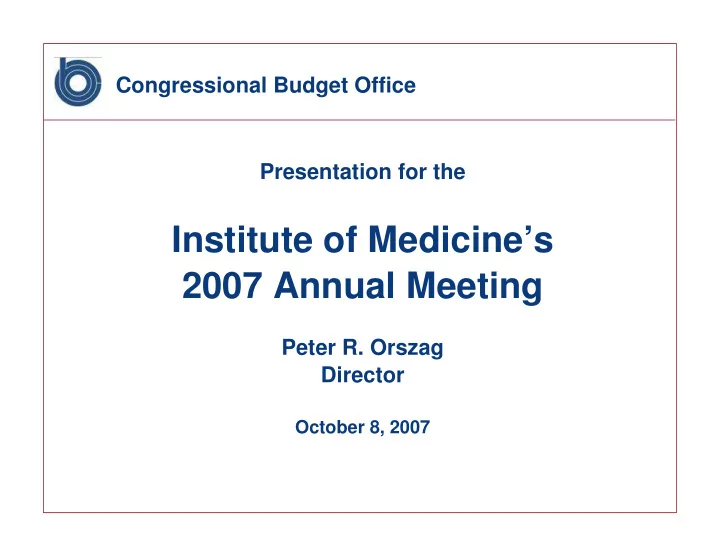

Congressional Budget Office Presentation for the Institute of Medicine’s 2007 Annual Meeting Peter R. Orszag Director October 8, 2007
Spending on Medicare and Medicaid and on Social Security as a Percentage of GDP, 2007 and 2017 7 Me dicaid Me dicare 5.9 6 Social Se curity 5 4 .8 1.9 4.6 4 .2 4 1.4 3 4 .8 4 .2 2 4.0 3.2 1 0 20 07 2 01 7
Total Federal Spending for Medicare and Medicaid Under Assumptions About the Health Cost Growth Differential Percent of GDP 25 Actual Projection Differential of: 2.5 Percentage Points 20 1 Percentage Point Zero 15 10 5 0 1966 1972 1978 1984 1990 1996 2002 2008 2014 2020 2026 2032 2038 2044 2050
Effects of Slowing the Growth of Spending for Medicare and Medicaid Percent of Gross Domestic Product 25 Actual Projection Differential of: 20 2.5 Percentage Points 1 Percentage Point Beginning in 2025 15 1 Percentage Point Beginning in 2015 10 5 0 1966 1972 1978 1984 1990 1996 2002 2008 2014 2020 2026 2032 2038 2044 2050
Medicare Spending per Capita in the United States, by Hospital Referral Region, 2003 $7,200 to 11,600 (74) 6,300 to < 6,800 (55) 4,500 to < 5,800 (72) 6,800 to < 7,200 (45) 5,800 to < 6,300 (60) Not Populated Source: www.dartmouthatlas.org.
The Relationship Between Quality and Medicare Spending, by State, 2004 Composite Measure of Quality of Care 88 83 78 73 4,000 5,000 6,000 7,000 8,000 Spending (Dollars) Source: Data from AHRQ and CMS.
Share of Personal Health Care Expenditures Paid Out of Pocket Percent 35 30 33% 25 26% 20 15 17% 15% 10 13% 5 0 1975 1985 1995 2005 2015
Effects of Cost Sharing Dollars per Enrollee 3,500 3,440 3,000 2,500 26% 2,000 2,228 2,116 1,500 15% 1,000 500 0 Free- Care Plan Conventional Plan High- Deductible Plan ($400 deductible, 25% ($4,000 deductible coinsurance, $4,000 limit) and limit) Source: Based on data from RAND’s health insurance experiment.
Costs and Impact of Comparative Effectiveness Research Depend on Type of Research § Systematic Reviews § Modeling § Analyses of Claims Data § Registries § Practical Clinical Trials § Randomized Controlled Trials
Other Factors Affecting Budgetary Impact § In the Short Term, Several Constraints – Time Needed to Generate New Findings, Reach Consensus – Time Needed to Incorporate Findings into Incentives – Changes to Medicare Required to Permit Full Adoption § In the Long Term, Savings Seem Likely – Currently, Providers Usually Have Incentives to Adopt New Technology, Enrollees Have Little “Skin in the Game,” and Payers Have Limited Information – Expanding the Evidence Base Thus Seems More Likely to Limit Future Spending Increases than to Fuel Them
Key Questions § Which Approach to Research is Most Cost-Effective? – More Evidence on Returns? § Relative Power of Information and Incentives? – Consumer-Directed or Value-Based Insurance? § Compare Clinical Effectiveness or Cost-Effectiveness of Treatments? § Roles for Private and Public Insurers? § How Much Could Spending/Variation be Reduced? – Would Health be Adversely Affected? § Impact on Level of Spending or Growth Rate?
Recommend
More recommend